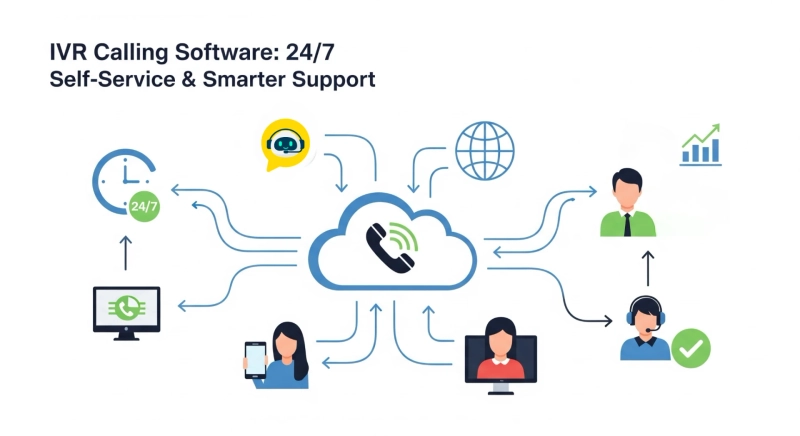IVR Calling Software delivers two big wins at once: always‑on self‑service for customers and meaningful cost savings for the business by automating routine requests and routing the rest to the right agents fast. Well‑designed IVR telephone systems shorten wait times, reduce call volumes that reach humans, and lift satisfaction by making support simple and predictable around the clock.
Why IVR matters now
IVR calling software greets callers, understands requests via speech or keypad, serves answers for common queries, and captures context so agents can solve issues faster when needed. Modern IVR telephone systems integrate with CRMs and back‑end apps to personalize menus and deliver up‑to‑date information instead of generic prompts.
24/7 self‑service, zero waiting
Customers can check balances, track orders, reset PINs, confirm appointments, and get business information any time without waiting for an agent, which removes frustration and makes support predictable. Always‑on access also helps global audiences because the same IVR workflow handles night, weekend, and cross‑time‑zone traffic without extra staffing.
Real cost savings, not just efficiencies
Automating frequent tasks cuts the number of calls that reach agents and the average cost per interaction, turning a heavy expense into a lighter, scalable operating cost. By deflecting routine volume, IVR frees teams to focus on higher‑value conversations, which lowers staffing pressure and training overhead while improving resolution quality.
Smarter routing improves first‑call resolution
When callers do need a person, IVR captures intent upfront and uses skills‑based rules to connect them with the best‑fit agent the first time, not after multiple transfers. This combination of context gathering and precise routing improves first‑contact resolution and shortens handle times for both customers and agents.
Shorter queues and faster answers
By offering self‑service first and directing only the right calls to people, IVR reduces queue length and wait times, which directly boosts satisfaction and reduces abandon rates. Even during spikes, IVR absorbs the surge by answering common needs immediately and placing complex issues in the most efficient queue.
Scales for peaks without proportional costs
Product launches, promotions, billing cycles, and seasonal spikes are easier to handle because IVR capacity scales with demand without hiring waves or adding seats and desks. As businesses grow or expand hours, the same IVR flows can be tuned and extended instead of rebuilt, maintaining consistent service quality at lower marginal cost.
Better data for continuous improvement
Every interaction—menu choices, intents, drop‑offs, and transfers—can be measured to reveal friction points, popular tasks, and training needs, so teams can refine flows and staffing in weeks, not quarters. Small businesses benefit too, projecting a professional image while using reporting and analytics to tune service and allocate resources smartly as they grow.
Features that make IVR feel effortless
Current IVR telephone systems support speech recognition and natural language input, so customers can say what they need in their own words instead of drilling through long menus. Menu logic can adapt by customer type, language, location, and history, while escalation rules ensure complex or sensitive issues jump quickly to people with the right skills.
Practical tips for getting it right
Keep menus short, lead with the most common tasks, offer a quick path to an agent, and use plain language to prevent dead‑ends and repeats. Review analytics regularly to remove low‑value steps, add new self‑service options for trending requests, and fine‑tune routing as products and policies evolve.
What success looks like
When IVR calling software is designed around customer jobs‑to‑be‑done, callers complete simple tasks quickly, reach specialists faster for complex issues, and rarely have to repeat themselves, all while the business spends less per interaction. The result is a service operation that is always available, measurably more efficient, and easier to scale without sacrificing the human touch where it matters most.
Bottom line
IVR calling software and IVR Telephone Systems are no longer “nice to have” they are essential infrastructure for 24/7 self‑service, lower cost per contact, and higher first‑call resolution in any modern contact center. Organizations that implement and iterate an IVR rooted in real customer needs gain durable advantages in satisfaction, speed, and unit economics that compound over time.



